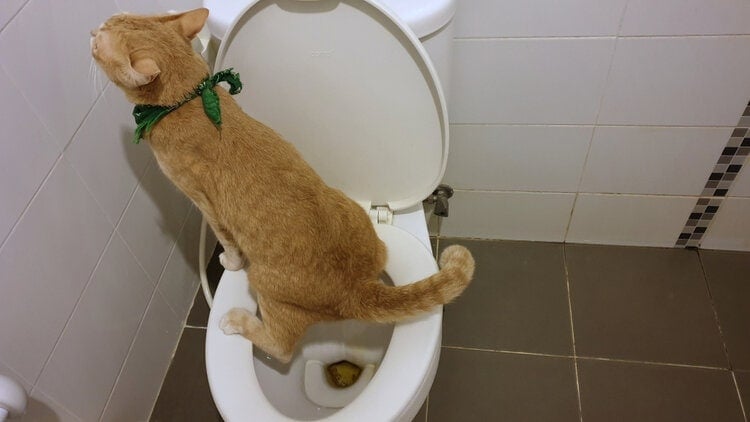Why Flushing Cat Poop Down Your Toilet Isn't a Good Idea - Tips for Safer Disposal
Why Flushing Cat Poop Down Your Toilet Isn't a Good Idea - Tips for Safer Disposal
Blog Article
What're your thoughts with regards to Don’t flush cat feces down the toilet?

Introduction
As cat proprietors, it's important to bear in mind how we throw away our feline close friends' waste. While it might appear hassle-free to purge cat poop down the toilet, this practice can have detrimental consequences for both the environment and human wellness.
Alternatives to Flushing
The good news is, there are more secure and a lot more accountable ways to dispose of cat poop. Consider the adhering to options:
1. Scoop and Dispose in Trash
The most common approach of taking care of feline poop is to scoop it into a naturally degradable bag and throw it in the trash. Make certain to utilize a dedicated trash inside story and get rid of the waste promptly.
2. Usage Biodegradable Litter
Opt for naturally degradable pet cat clutter made from products such as corn or wheat. These litters are environmentally friendly and can be securely gotten rid of in the garbage.
3. Bury in the Yard
If you have a lawn, take into consideration burying feline waste in a marked area away from veggie gardens and water sources. Make sure to dig deep adequate to stop contamination of groundwater.
4. Install a Pet Waste Disposal System
Purchase a family pet garbage disposal system especially designed for cat waste. These systems use enzymes to break down the waste, decreasing smell and ecological influence.
Wellness Risks
Along with ecological worries, purging feline waste can likewise position health risks to people. Cat feces may have Toxoplasma gondii, a bloodsucker that can trigger toxoplasmosis-- a potentially severe ailment, specifically for expecting women and people with weakened immune systems.
Ecological Impact
Flushing cat poop presents damaging pathogens and bloodsuckers into the supply of water, presenting a significant risk to water communities. These pollutants can adversely impact marine life and compromise water high quality.
Conclusion
Accountable pet possession expands beyond offering food and shelter-- it likewise includes appropriate waste administration. By refraining from purging pet cat poop down the commode and going with different disposal techniques, we can lessen our environmental footprint and safeguard human health.
Why Can’t I Flush Cat Poop?
It Spreads a Parasite
Cats are frequently infected with a parasite called toxoplasma gondii. The parasite causes an infection called toxoplasmosis. It is usually harmless to cats. The parasite only uses cat poop as a host for its eggs. Otherwise, the cat’s immune system usually keeps the infection at low enough levels to maintain its own health. But it does not stop the develop of eggs. These eggs are tiny and surprisingly tough. They may survive for a year before they begin to grow. But that’s the problem.
Our wastewater system is not designed to deal with toxoplasmosis eggs. Instead, most eggs will flush from your toilet into sewers and wastewater management plants. After the sewage is treated for many other harmful things in it, it is typically released into local rivers, lakes, or oceans. Here, the toxoplasmosis eggs can find new hosts, including starfish, crabs, otters, and many other wildlife. For many, this is a significant risk to their health. Toxoplasmosis can also end up infecting water sources that are important for agriculture, which means our deer, pigs, and sheep can get infected too.
Is There Risk to Humans?
There can be a risk to human life from flushing cat poop down the toilet. If you do so, the parasites from your cat’s poop can end up in shellfish, game animals, or livestock. If this meat is then served raw or undercooked, the people who eat it can get sick.
In fact, according to the CDC, 40 million people in the United States are infected with toxoplasma gondii. They get it from exposure to infected seafood, or from some kind of cat poop contamination, like drinking from a stream that is contaminated or touching anything that has come into contact with cat poop. That includes just cleaning a cat litter box.
Most people who get infected with these parasites will not develop any symptoms. However, for pregnant women or for those with compromised immune systems, the parasite can cause severe health problems.
How to Handle Cat Poop
The best way to handle cat poop is actually to clean the box more often. The eggs that the parasite sheds will not become active until one to five days after the cat poops. That means that if you clean daily, you’re much less likely to come into direct contact with infectious eggs.
That said, always dispose of cat poop in the garbage and not down the toilet. Wash your hands before and after you clean the litter box, and bring the bag of poop right outside to your garbage bins.
https://trenchlesssolutionsusa.com/why-cant-i-flush-cat-poop/

I hope you enjoyed our part on Can You Flush Cat Poop Down The Toilet?. Thanks a ton for taking a few minutes to read our article. Do you know about another person who is interested in the subject? Take a moment to promote it. I love reading our article about Don’t flush cat feces down the toilet.
Book Service Report this page